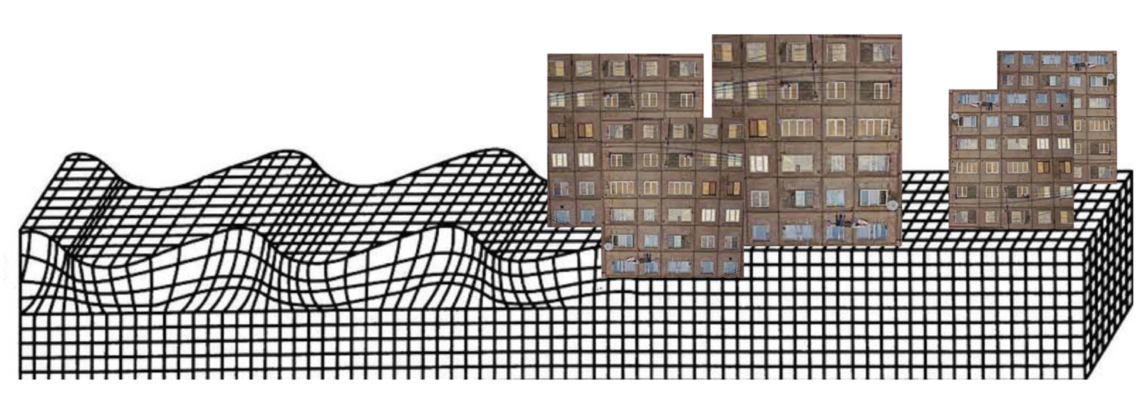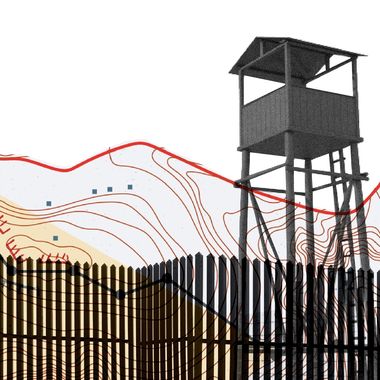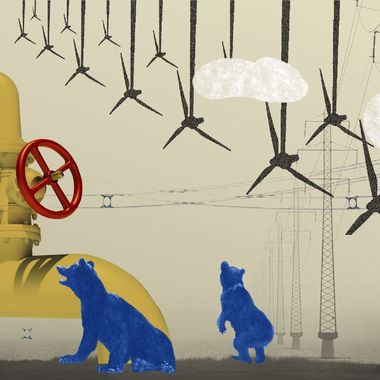
The 4.7 magnitude earthquake that rattled Yerevan on February 13, 2020 was alarming. Fortunately, it was not strong enough to cause significant harm to people or structures. It did, however, trigger an inescapable question: Can Armenia withstand another major earthquake?
In 1988, the 6.8 magnitude Spitak Earthquake took the lives of approximately 50,000 people, injured around 130,000 and left more than 500,000 homeless, leaving behind deep challenges that Armenia, and especially the second-largest city of Gyumri, has yet to overcome.
More than 300 buildings collapsed that day. Although Soviet Armenian buildings were engineered to withstand a maximum 7.0 magnitude earthquake, shortcuts were taken during the construction phase of buildings constructed in the later Soviet period, when corruption had become entrenched. For example, concrete may have been mixed with inadequate amounts of cement so that the excess could be sold into the black market.
Specialists now conclude that the maximum seismic risk for Armenia is up to a 9.0 magnitude earthquake. Since the Richter scale is logarithmic, that corresponds to a tremor one hundred times as intense as the one in 1988. In 2011, Japan experienced a 9.0 magnitude earthquake that triggered a tsunami and the Fukushima nuclear disaster. If an event that intense were to actually strike Armenia, some estimates expect that 70-80% of the building stock could be severely damaged resulting in countless deaths.
The Government Regulators
The Regional Survey for Seismic Protection (RSSP) is the organization within the Ministry of Emergency Situations (MES) that is responsible for seismic assessment and security. The RSSP and MES work closely with the Garni Geophysical Observatory, one of the few serious seismic assessment and analysis centers in the region.
The Urban Development Committee (UDC) is another governmental body that is designed to solve a variety of urban development and planning issues, including the seismic protection of Armenia’s building stock. The UDC develops policies which they help implement through regional and municipal authorities.
The Earthquake Resistant Construction Design Codes, prepared with the help of the UDC, is a legally-binding document that requires planners and engineers to follow certain seismic security guidelines. The document was first introduced in 1994 and was recently updated in December 2020, with the financial assistance of the Asian Development Fund (ADF).
According to David Grigoryan, the Deputy Chairman of the Committee and one of the authors of the newly-adopted building codes, the document was assessed by a team of local and international specialists to ensure it followed universally-accepted practices, though it diverges from some international standards.
New Buildings
Having reassessed Armenia’s seismic risk, the current building code obliges new buildings to be more secure than the ones built in the Soviet era. This is enforced by private inspectors who go over construction plans to make sure they meet seismic protection and other criteria. These examiners work for limited liability for-profit companies that are licensed to carry out this type of work. They are also responsible for assessing the construction process to ensure building code guidelines are followed.
However, according to Gurgen Namalyan, the Deputy Head of the RSSP and Head of the Seismic Vulnerability Assessment Division, many developers - especially of residential buildings - bribe their way through the system by paying inspectors to sign off plans as seismic-proof in an effort to cut costs and increase profit. Sometimes, they may even add additional floors without getting government approval.
Namalyan said that he has inspected building plans himself and does not trust the work that examiners currently do. “Looking at all the builders in Armenia, you would not even find 20 good ones,” he added.
Grigoryan shared a similar view, “Although we have great planners, we also have really bad ones. Unfortunately, some of them are completely unaware of building codes.” For that reason, they are considering making a few changes to the current examination legislation by the end of the year. They will either replace the current system of private company inspectors with a state body, or they will enforce stricter measures by tightening the process of giving out licenses and filtering out unqualified examiners.
Old Buildings
If implemented, Grigoryan’s suggestion would somewhat solve the issue for new construction. However, the approximately 70% of Armenia’s building stock that dates from the Soviet period would be left untouched, and vulnerable to varying degrees. Highly vulnerable ones should be demolished. For example, Namalyan referred to the 111 EES04 series of 9-storey buildings. In Gyumri, 96 of the 135 buildings of this type collapsed in 1988. The same design of buildings can be found in Yerevan and constitute around 14% of the stock. Other designs pose less risk and can be reinforced.
Tanya Arzumanyan, Head of the UDC’s Housing and Communal Infrastructure Department, explained that only a select few reinforcement projects have been implemented to date. That being said, the state does not have a clear picture of the seismic vulnerability of its building stock, which is a precondition to starting any serious work around reinforcement.
For that reason, the UDC has proposed creating a database of the country’s building stock, including information on the seismic risk of buildings. This would help categorize the building stock from the most to least vulnerable and facilitate the prioritization of which buildings need attention.
The proposal was reviewed by the Ministry of Justice, which submitted suggestions for improvement. The legislative package now needs to be revised and eventually sent to the National Assembly. Arzumanyan hopes it will be possible to adopt it by the end of 2021.
Even if the identification system is fully implemented, the government would still need funding to demolish or reinforce vulnerable buildings while providing temporary shelter for residents.
Engineering Professor Mikayel Melkumyan believes that schools, hospitals and government buildings should be reinforced first because they represent the important community infrastructure that would be needed as part of the response if a strong earthquake occurs.
With this conviction, Melkumyan was part of a team of professionals, also including the RSSP, that led a $100 million school reinforcement project in 2015 with the joint assistance of the ADF and the Armenian government. After examining around 1500 schools, they identified the 48 most vulnerable, which will be demolished or reinforced by 2030.
Seismic Protection Technologies
Seismic base and roof isolation systems are one of the most commonly used technologies to protect buildings against earthquakes. These are supplemental security measures that are added to buildings.
Melkumyan, who has his own seismic technology company, was arguably the first engineer to introduce seismic isolation in Armenia in the mid-1990s, when he retrofitted the first building with base isolators. Since then, he has used 5,200 isolators in 50 old and new buildings around Armenia, such as the highrise Elite Plaza Business Center in Yerevan.
Melkumyan argues that the cost of buildings he designs, inclusive of the cost of the isolators he uses, is 30-40% cheaper than the cost of standard buildings that meet the basic requirements of Armenia’s building code. He also stresses that the isolators he uses, which are manufactured locally, have a lifespan equal to that of the buildings they are used in. Others suggest that they may need to be periodically replaced.
When it comes to old buildings, he also argues that using his isolation systems can be 3-5 times cheaper than traditional reinforcement methods, such as reinforced concrete jacketing or steel jacketing. Additionally, when using his method, residents can remain in their building during the retrofit, he explained.
Arzumanyan expressed her doubts about Melkumyan’s arguments, saying that not having the labs needed to test these technologies is one of the sad realities in Armenia.
Arzumanyan added that, despite the fact that the government helps reinforce buildings when needed, it is not legally obligated to do so. As such, there is an expectation that citizens should also take an active interest and get involved in this cause.
Despite the varying experiences and opinions around seismic protection in Armenia, there was common agreement between the RSSP, the UDC and Melkumyan that Armenians have not cultivated enough lessons from the Spitak earthquake.
A saying in the industry goes, “Earthquakes don’t kill people, buildings do.” Armenia had some good luck on February 13. On the same day, Japan experienced a much stronger 7.1 magnitude earthquake on the other side of the world. Japan does use isolation systems to mitigate seismic risk. Though building damage was reported, there was only one official death.
Author's Note: Special thanks to RSSP Chief Adviser, Hrachya Petrosyan, whose insight helped shape this article.
also read

The 2020 Artsakh War highlighted the urgency of addressing security pitfalls. The January 2021 issue of EVN Report's Magazine, entitled "Security," covers a wide spectrum of security concerns facing Armenia.
Avoiding the Empty Nest: Armenia’s Demographic Security
By Hovhannes Nazaretyan
Armenia’s significant demographic decline over the past 30 years due to emigration and declining birth rates has affected nearly all areas of life in the country from industry to education to the military.
Armenia’s New Security Architecture: Russia as Geopolitical Bodyguard
By Nerses Kopalyan
Armenia needs to reconfigure the political economy of its security architecture by utilizing its security alliance with Russia, through a mechanism of burden-sharing, where Russia’s geopolitical interests are aligned with Armenia’s security interests.
The Cyber Battlefield is Just as Important: Armenia’s Cybersecurity
By Artur Papyan
The scale and level of coordination of cyberattacks by Azerbaijani hackers in 2020, indicates careful planning and centralized coordination. Artur Papyan writes about the need for education about cybersecurity in Armenia, in both the private and public sectors.
Armenia’s Food Security
By Lusine Sargsyan
In a world where pandemics, extreme climatic phenomena and natural disasters are becoming more common, the issue of food security is a global challenge of increasing importance. Armenia is not immune to these developments.
Laying Off the Gas: Energy Security in Armenia
By Yelena Vardanyan
Diversifying Armenia’s energy sources is a strategic need of national importance. The coming decade presents an opportunity to turn direction and tackle the considerable obstacles facing the country. Strong political commitments and a focused approach are needed to make real progress.
Armenia’s Environmental Security
By Irina Ghaplanyan , Erik Grigoryan
Armenia has an incredible potential to tap into its natural resources sustainably and moreover ensure green economic growth. What is needed is visionary thinking as well as effective, professional and technocratic governance.









